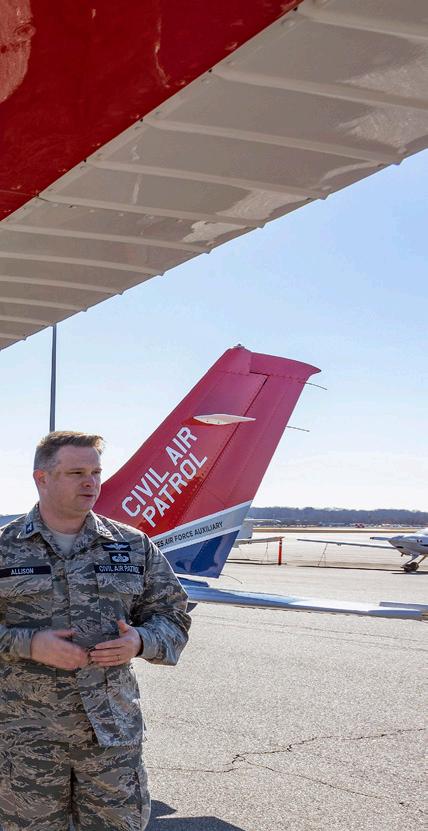
6 minute read
Bobby Allison: Serving in the Civil Air Patrol


BY DAVID NILLES
ON ANY GIVEN WORKDAY, YOU CAN FIND BOBBY ALLISON SERVING IN THE
MAINTENANCE DIVISION AS ArDOT’S
INFORMATION TECHNOLOGY SYSTEMS (ITS) OPERATIONS SUPERVISOR. It is here that he manages the Department’s ITS system including the two-way radio network, the VHF (Very High Frequency) system for the Department and Arkansas Highway Police and anything ITS-related such as traffic cameras, digital message boards and highway advisory radios. Allison has 17 years with the Department. As if that weren't enough to keep him busy, you may find him flying overhead in a Cessna 182T as a member of the Arkansas wing of the Civil Air Patrol (CAP). Allison has been in the Civil Air Patrol for 25 years and today serves as Wing Commander for Arkansas, coordinating ten squadrons across the State.
A LOVE FOR MILITARY SERVICE Allison’s involvement with the CAP began early in life.
“I started in the Civil Air Patrol when I was 13 years old. I was in their Cadet program for four years and loved it so much that I stuck with it when my cadet time was up,” Allison shared. “I was all about the military and service in general. My family has a diverse military background. Unfortunately, I could not join the military due to a medical disqualification so I decided to stick with CAP. I definitely enjoy the service and what the Air Patrol does.”
THE ROLE OF THE CIVIL AIR PATROL
The Civil Air Patrol is the country’s premier public service organization for conducting emergency services and disaster relief missions nationwide. As (continued on page 18)

the official auxiliary of the U.S. Air Force, CAP’s citizen volunteers search for and find lost citizens, provide comfort on the ground in times of disaster and work to keep the homeland safe. Its 60,000 members devote their time, energy and expertise toward the well-being of their communities. They also promote aviation and related fields through aerospace education and help shape future leaders through CAP’s Cadet Program.
IN THE AIR “Nationwide, we have a fleet of more than 560 aircraft,” Allison explained. “In Arkansas, we have seven aircraft based around the State. The majority are Cessna 172Ts and 182Ts, and they are the backbone of our fleet. Those aircraft enable us to do many of the missions the Air Force and other agencies charge us with, such as aerial damage assessment


and disaster relief, or search and rescue.”
Allison serves as an aircrew member when airborne. Usually, he is positioned in the right hand seat serving as the mission observer.
“As observer, I work the radio and keep track of the mission,” Allison explained. “Other times, I serve as the specialty mission scanner which means I’m in the back of the plane operating a camera in the plane’s camera window. It takes time and practice to steady the camera, get the right settings and get a good shot with the aircraft vibrating and the wind passing over. So on any given mission, we have a pilot and mission observer up front and someone in back taking photos.”

“We are involved with disaster relief and damage assessment,” Allison added. “For example, during the Arkansas River flooding last year, CAP did 95 percent of the photography of the flooded areas. The wing put in more than 400 man-hours and 40 deployments flying aerial photography missions to provide incident assessment and awareness to State officials and the National Guard. CAP took thousands of digital images that were provided for the Wing’s Unclassified Processing, Assessment and Dissemination capabilities. Those images went to the Arkansas Division of Emergency Management.
We also do other missions. We help the Air Force in escorting unmanned aerial aircraft or Small Unmanned Aircraft Systems and remotely piloted aircraft (drones). We also do counter drug operations and border patrol operations. There are other missions where CAP assists Air Force units practicing intercept air defense. We are the targets, and they track and find us.”
SERVICES ON THE GROUND In addition to work in the air, CAP assists in local communities with work on the ground. “Our aircraft need someone on the ground as a liaison during a search and rescue mission or during disaster relief. We have ground teams that train specifically for that. We also have Civilian Emergency Response Training for disaster situations. The trainings are hosted by the Red Cross or another emergency management agency.”

THE CAP CADET PROGRAM Civil Air Patrol’s Cadet Program is aimed at young people ages 12 to 20 and transforms youth into future aerospace leaders through a curriculum that focuses on leadership, aerospace, fitness and character. As Cadets participate in these areas, they advance through a series of achievements, earning honors and increased responsibilities along the way. Many of the nation’s astronauts, pilots, engineers and scientists first explored their careers through CAP. Currently there are 1,000 local squadrons nationwide involving 25,000 young people. “I got my start in the Cadet program,” Allison shared. “We are always recruiting young people. We recruit through schools or set up at airports for air shows. Word of mouth is a huge recruiting tool as well. In Arkansas, we have approximately 460 students involved. “We promote flying and get Cadets up in the air whenever we can for orientation flights. We also provide scholarship opportunities to help them get their pilots licenses. Many go on to become pilots. If these Cadets want to join the military later in life, the Cadet program gives them a step above everyone else when they hit age 18 or 19. As a former Cadet, I can’t say enough about this program!”
AEROSPACE EDUCATION
Civil Air Patrol’s award-winning aerospace education program promotes aerospace, aviation and STEM-related careers with standards-based, hands-on curriculum and activities for students. “Our wing is one of the leaders when it comes to aerospace and STEM. We have a program allowing teachers access to STEM kits, our library of aerospace topics and different resources. We have kits for science, technology, engineering and math ready to go into classrooms. We work with NASA’s Arkansas Space Grant Consortium which provides us grant money each year to help provide resources for teachers.”
A LOVE FOR THE PATROL Allison was promoted to Colonel last October, the same time he was named Wing Commander.
“I love what we do and think we provide a great service to the nation. I enjoy being a part of it. I believe in our mission as a volunteer force, and I enjoy giving back to our community.”
As Wing Commander, Allison could not help but put in a plug for future volunteers.
“We have jobs doing any number of things — administrative, personnel, logistics, public affairs, photographers, pilots — every little bit helps and adds up!”










